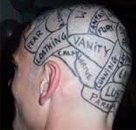Monday, 29 February 2016
When Advertisements Steal Our Attention

A New York Times article by Matthew B. Crawford, entitled “The Cost of Paying Attention” (first link below) analyzes the way that the public space is being invaded by advertising. First, he points out that attention is a limited cognitive resource. He shows how private businesses are waging a veritable war to appropriate our “private head space” with advertising messages, thus making it harder and harder for us to resist these constant, alienating “bottom-up” stimuli and exercise “top-down” control over our own thoughts. In this process, says Crawford, we are losing something vital: “Just as clean air makes it possible to breathe, silence makes it possible to think.” (more…)
The Emergence of Consciousness | No comments
Monday, 15 February 2016
Neural Reuse as a Way of Moving Beyond Phrenology

Michael Anderson’s book After Phrenology: Neural Reuse and the Interactive Brain, published in December 2014, offers a relatively new way of looking at the human brain. Phrenology, referred to in the the book’s title, was a pseudo-discipline developed by Franz Joseph Gall in the early 19th century. It postulated that the brain was composed of various modules corresponding to various functions or behaviours observable in human beings. It also postulated that the bumps in a person’s skull corresponded to the personality traits that were more or less developed in that individual, such as mirthfulness, benevolence, ambitiousness, or cautiousness. (more…)
Evolution and the Brain | No comments
Monday, 1 February 2016
Two Scientific Models Called into Question

Every scientific theory consists of models that can be used to generate hypotheses that can be tested by observation or experimentation. If the observations or experimental results are inconsistent with what the models predict, then the models themselves must be called into question. Recent developments in neuroscience provide two examples of models that are going to have to be adjusted to such “abnormal data”, as Thomas Kuhn has called them. (more…)
From Thought to Language, Mental Disorders | No comments







